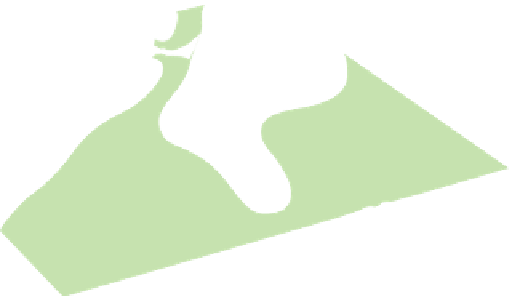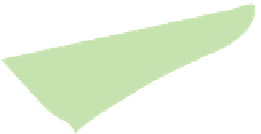Geoscience Reference
In-Depth Information
is common and occurs either well dispersed, con-
centrated into carbonaceous siltstones or even as
thin, 'drifted' coals. Rooting and soft-sediment
deformation are locally recognised. The type and
intensity of bioturbation is variable. Some inter-
vals are non-bioturbated, whilst others show occa-
sional rooting or non-specific burrow mottling.
Planolites montanus
is dominant in low diversity
assemblages, whilst
Taenidium
is occasionally
present.
Crevasse splay deposits (FA 4) are interbedded
with the other types of floodplain deposits (Fig. 9).
Individual beds are 0.3 m to 1 m thick sandstones
displaying current ripple cross-lamination (with
locally climbing current ripples) and planar
lamination. Many sandstone beds preserve carbo-
naceous rootlets, whilst others show a mottled
fabric without rootlets, most likely related to
pedogenic processes. The trace fossils
Taenidium
and
Planolites montanus
are observed.
These floodplain facies associations provide
evidence of an extensive, low-lying, muddy coastal
plain and humid climate (Fig. 11). Although much
of the floodplain was characterised by extensive
shallow lakes, ponds and peat swamps, better
drained areas allowed mature palaeosols to
develop. Crevasse splay sands were introduced to
the floodplain during peak fluvial discharge peri-
ods via crevasse channel systems.
The peat swamps and highly vegetated flood-
plain areas most likely constituted stable substrates
Fig. 10.
Core photograph from Åre 1 Zone in well 6507/
7-A38. Typical fluvial facies showing fine-laminated lacus-
trine claystone (FA 2); carbonaceous claystone representing
peat swamp deposits (FA 1); and cross-stratified fluvial
channel sandstone (FA 5). The ruler is 1.0 m long.
Field-scale trunk fluvial channel system,
potentialy braided and showing strong evidence
of vertical accretion
Extensive shallow lake
Crevasse splay lobes fed by
crevasse channel
Multi-storey/multi-lateral
fluvial channel-fill generated
by meander belt
Fringing cycad thickets on
better drained substrates
Peat swamp
Lacustrine deposits
Crevasse splay deposits
Fig. 11.
Conceptual model for the Åre Formation coastal plain setting (reservoir zones Åre 1 and 2).













































































































Search WWH ::

Custom Search